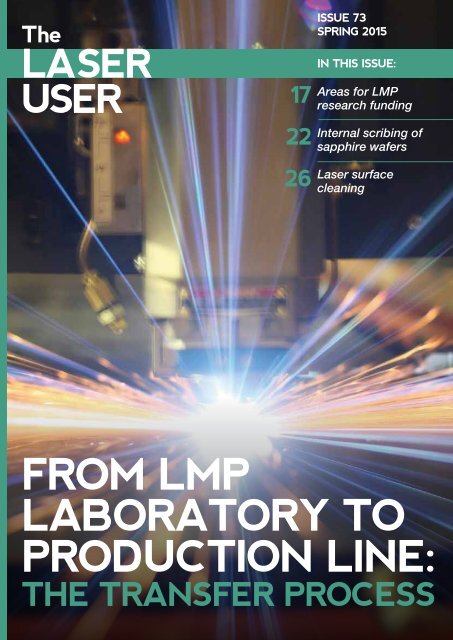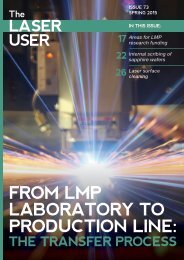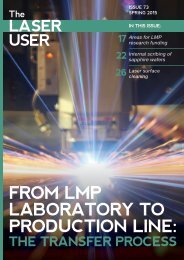Issue 73 Public preview version (4 pages)
Create successful ePaper yourself
Turn your PDF publications into a flip-book with our unique Google optimized e-Paper software.
The<br />
LASER<br />
USER<br />
17<br />
22<br />
26<br />
ISSUE <strong>73</strong> SPRING 2015<br />
ISSUE <strong>73</strong><br />
SPRING 2015<br />
IN THIS ISSUE:<br />
Areas for LMP<br />
research funding<br />
Internal scribing of<br />
sapphire wafers<br />
Laser surface<br />
cleaning<br />
FROM LMP<br />
LABORATORY TO<br />
PRODUCTION LINE:<br />
THE TRANSFER PROCESS<br />
1
ISSUE <strong>73</strong> SPRING 2015<br />
CONTENTS<br />
HIGHLIGHTS...<br />
Areas for LMP<br />
research funding<br />
17<br />
Step by step<br />
to funding<br />
18<br />
New safety standard<br />
for laser products<br />
20<br />
Internal scribing<br />
of sapphire wafers<br />
22<br />
Hybrid laser<br />
welding in situ<br />
24<br />
Laser surface<br />
cleaning<br />
26<br />
MEMBERS’ NEWS<br />
Association News 1<br />
Business 2<br />
Sources & beam delivery 4<br />
Beam delivery and component<br />
manipulation 6<br />
Materials Processing 7<br />
EDITORIAL<br />
Job Shop Corner: 12<br />
Chairman’s report 13<br />
Interview: Stewart Williams,<br />
Cranfield University 14<br />
President’s message 15<br />
Sharp Comment 15<br />
REVIEWS<br />
Observations 29<br />
Innovations for Economic<br />
Growth workshop 31<br />
Editor’s note 32<br />
Dates for your diary 33<br />
FEATURES<br />
Lighting the way to collaborative<br />
opportunities for the industrial<br />
laser community<br />
Karen Brakspear 16<br />
How to fund your new product<br />
ideas with public money<br />
Roger Hardacre 18<br />
The new edition of IEC 60825-1<br />
‘Safety of laser products - Part 1:<br />
Equipment classification<br />
and requirements<br />
Mike Barrett 20<br />
Picosecond pulse widths provide<br />
improved capabilities to<br />
micro-processing applications<br />
Tim Gerke 22<br />
Laser/ GMAW hybrid welding:<br />
two university industrial case<br />
studies<br />
Wojciech Suder and<br />
Stewart Williams 24<br />
CONTENT BY SUBJECT<br />
Business<br />
UK LMP Roadmap 2<br />
Members’ news 3<br />
AILU interview 14<br />
Lighting the way 16<br />
Funding areas 17<br />
How to fund your product 18<br />
Case studies<br />
Members’ news 11<br />
Hybrid welding case studies 24<br />
Job Shop<br />
Members’ news 12<br />
Chairman’s report 13<br />
Sources, beam delivery,<br />
measurement, positioning<br />
Members’ news 4-6<br />
Materials Processing products<br />
Members’ news 7-10<br />
Cleaning<br />
Surface cleaning and welding 26<br />
Marking<br />
High value marking 11<br />
Micro-processing<br />
Ultra short pulse lasers 22<br />
Welding<br />
Members’ news 8,9<br />
Hybrid welding case studies 24<br />
Surface cleaning and welding 26<br />
Safety<br />
New edition of IEC 60825-1 20<br />
Workshops<br />
ILAS 2015 1<br />
Solutions workshop 1,33<br />
Sharp Comment 15<br />
Innovations for economic<br />
growth 31<br />
Dates for your diary 33<br />
Laser surface cleaning in laser<br />
welding of aluminium alloy<br />
for automotive component<br />
manufacture<br />
Ahmad Wael Al Shaer, Lin Li<br />
and Anil Mistry 26<br />
2
“<br />
ISSUE <strong>73</strong> SPRING 2015<br />
INTERVIEW<br />
“<br />
THE TRANSITION<br />
FROM INDUSTRY<br />
TO ACADEMIA<br />
AN INTERVIEW WITH STEWART WILLIAMS<br />
DIRECTOR OF THE WELDING ENGINEERING<br />
AND LASER PROCESSING CENTRE<br />
s.williams@cranfield.ac.uk<br />
Q. What do you see as the role of the Welding Engineering<br />
and Laser Processing Centre at Cranfield University in<br />
supporting the laser material processing community?<br />
We have three principal roles. First is provision of a steady supply of<br />
high quality trained researchers and engineers for deployment in industry<br />
and other research institutions. Secondly we need to research into the<br />
fundamental science and understanding of laser material processing so<br />
that we can develop innovative ideas and robust industrial processes.<br />
Our third role is taking innovative ideas and developing them through to a<br />
level of maturity where exploiters can assess the potential benefits. These<br />
ideas can then be taken forward through<br />
a variety of routes including directly with<br />
industry or through the Catapults or<br />
similar.<br />
Q. How would you describe<br />
your interests and activities<br />
in Laser Materials Processing<br />
(LMP) at Cranfield University?<br />
Our interests are mainly focused on<br />
fusion based processes. This of course<br />
includes welding, through very large<br />
structures such as ships to micro devices<br />
needed for consumer goods and medical<br />
applications. Often welding is divided into micro and macro and this always<br />
surprises me. The basic physics and chemistry is the same, whatever the<br />
length scale. Other LMP activities include additive manufacture; cutting;<br />
and (just beginning) low cost laser peening.<br />
Q. In terms of facilities, staff and student support how<br />
do you think your ability to conduct LMP at Cranfield<br />
University without undergraduates, compares to that of<br />
your colleagues in more traditional universities?<br />
I believe our facilities are excellent. We have three laser laboratories<br />
containing lasers ranging from an 8 kW fibre laser through too small pulsed<br />
systems. These laser are supported by various robotic or gantry motion<br />
systems, enclosures and analysis equipment. These facilities are supported<br />
by donations or loans from industry and this is much appreciated. I think<br />
the absence of undergraduates is a real benefit: it allows us to concentrate<br />
on research. I am sure many of my contemporaries would envy our<br />
position. The main downside is that we do not get a direct feed of high<br />
quality UK students.<br />
Q. What is your assessment of the current state of<br />
health of the LMP community in the UK?<br />
In terms of the research community it is quite robust but I would say<br />
significantly smaller than it was 10 to 15 years ago. I believe this is<br />
I think there will be many<br />
other opportunities for LMP in<br />
the aerospace sector. This is<br />
especially in the metals field.<br />
because lasers are not as fashionable (with funding bodies and industry)<br />
as they once were and have been superseded by other fads such as nano<br />
and now additive. As we know, the industrial LMP community is much<br />
smaller than we would like it to be. I also think it has an extremely low<br />
profile, which does not help our situation.<br />
The Technology Strategy Board supports a number of Catapults, including<br />
one in High Value Manufacturing with a significant LMP content; and<br />
the EPSRC has recently launched a Centre for Innovative Manufacturing<br />
in Laser-based Production Processes. Should UK universities in LMP<br />
research feel threatened or comforted by these developments?<br />
I think we should be comforted by these<br />
developments. Despite LMP not being<br />
fashionable at least the funding bodies<br />
and industry are supporting the field.<br />
Q. How much one-to-one<br />
assistance does your Centre<br />
provide to UK industry,<br />
including SMEs? Are you able<br />
to meet the low costs and<br />
short timescales that industry<br />
demands?<br />
I do not see direct industry support as<br />
our main role and there are other organisations where this is a primary<br />
activity. However we do and have provided this when requested. We would<br />
prefer to engage with companies through the EPSRC Centre for Innovative<br />
Manufacture in Laser Based Production. Going through the Centre means<br />
we can respond in a timely manner as we have research staff available for<br />
short term studies. It also means we may be able to support the industry<br />
requirements with government funding. Indeed, for SMEs there is funding<br />
set aside for direct support at no cost to the industrial partner.<br />
Q. From what you see of UK laser use in manufacturing,<br />
do you see it growing? Do you foresee the UK ever<br />
approach Germany in its industrial use of lasers?<br />
One of the main goals for the CIM is to increase the uptake of lasers in UK<br />
manufacturing industry so I would say yes I expect it to grow. However I<br />
think we need to consider why there is such a poor uptake. The main reason<br />
I believe is the short term financially-based thinking of many managers in<br />
UK companies. My experience of working in industry was a very frustrating<br />
one. Whilst we came up with many innovative ideas and technical solutions<br />
to problems the response of those in the business units was always to find<br />
reasons why we couldn’t adopt them or investigate them further. This was<br />
especially the case if it involved some significant investment.<br />
Q. With your background at BAE Systems before<br />
taking up your position at Cranfield, you are in a unique<br />
3
Please Register to see the<br />
Full Version of this magazine<br />
http://www.ailu.org.uk/full-<strong>version</strong>-members-only/




